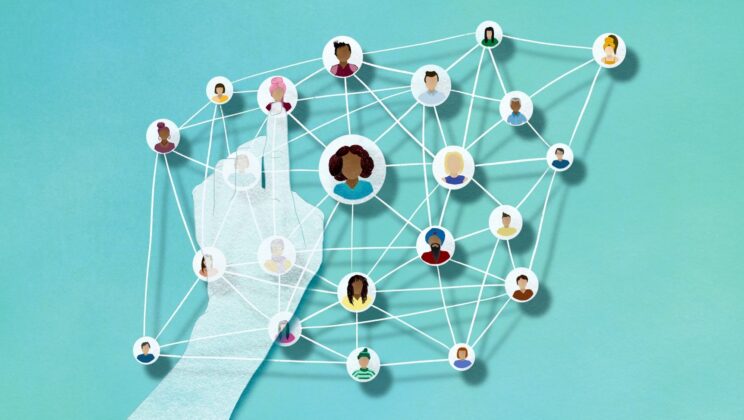Destigmatizing BIPOC Mental Health
October 20, 2022
Black, Indigenous, and people of color (BIPOC) communities are facing high levels of anxiety and stress after years of disturbing events. We’ve lived through a worldwide pandemic, endured one news story after another of police brutality and racially motivated killings, and experienced political rancor that has swept the nation.
This caused or worsened mental health problems for many BIPOC individuals, and stigma around mental health can make it harder for them to seek the treatment they need.
What causes this stigma? Several factors are at play:
- Silence on the topic. Many BIPOC individuals grew up in communities and families that didn’t openly discuss mental health. This lack of communication may send the inaccurate message that no one else struggles with similar problems, or that something is “wrong” with them.
- Reliance on non-professional sources of support. Often BIPOC clients grew up in an environment that encouraged them to rely on friends, family, and religious leaders for help with internal conflicts, rather than seeking treatment from trained providers. Family and trusted leaders are wonderful resources, but professionals can help in ways they cannot.
- Hypermasculine stereotypes. Stereotypes about hypermasculinity are prevalent within some BIPOC communities. This can make it especially difficult for men to admit that they need help with a problem—from a therapist or from anyone else.
As clinicians, we should open the door for conversations that can help destigmatize mental health. The first step is to establish trust.
The foundation of trust
To have effective conversations with clients, you must first build strong rapport with them. This can be tricky when a client’s cultural upbringing has left them feeling conflicted about mental health treatment. They may be alert to signals indicating whether or not they can trust you.
The foundation of a healthy provider-client relationship is to meet your client where they’re at and find out what makes them comfortable (and uncomfortable). I learned this early in my career when I worked with homeless individuals in New York City. Talking wasn’t always their first priority because they had more urgent needs competing for their attention: hunger, thirst, cold, exhaustion. I learned that if I brought a bottle of water on a hot day, coffee on a cold day, or bought them lunch on a park bench, they were much more likely to complete an assessment and get connected to services. Sometimes they didn’t want to talk, and I would just check in with them periodically until the day they were ready to open up. This perspective has helped me with many other clients of different ages and backgrounds throughout my years as a provider.
So meet your BIPOC clients where they’re at, and tailor your approach to their comfort level. To be successful at this, here are five steps to take early in the treatment relationship.
-
Educate yourself about your client’s culture
If you’re not a member of the BIPOC community but have BIPOC clients, or if you are BIPOC but see clients whose backgrounds and cultural heritage are very different from yours, you’ll need to do your own research to understand that background.
One of the biggest mistakes we therapists can make is to put the onus on the client to educate us about their culture. They’re already working hard by asking for help in the first place. Our part of the work is to approach them from a place of knowledge.
For example, I am a Black woman. I understand a lot about the Black experience in America and, in general, what family dynamics tend to be like in Black communities. But if I treat a South Asian client who’s having conflict with her parents, I have some research to do. South Asian cultures have different guidelines and assumptions regarding how children communicate with their parents than the ones I grew up with. As a Black woman, I won’t understand those nuances until I seek out the information.
-
Be authentic and self-aware
It’s OK to admit to clients that you don’t know everything about their cultural background. As long as you’re working to educate yourself, it’s perfectly acceptable to say, “I have not experienced that and don’t know exactly what it feels like, but from what you’re saying, it sounds difficult. I want to help you get unstuck from these paralyzing feelings and move toward a healthier mental place.”
Working with clients from outside your own demographic takes self-knowledge. You have to understand your own strengths, weaknesses, areas of ignorance, and triggers. You may make mistakes in a session, and it’s OK to acknowledge that, apologize, and work to do better.
-
Be a collaborator, not an instructor
It’s hard to build rapport and trust with BIPOC clients if they feel that you’re the teacher or authority. That can feel condescending. They need to know that the two of you are partners working together for their mental health.
Try to speak to clients in layman’s terms. Explain things in such a way that someone with no training in counseling could understand the concepts.
It also may be valuable to identify what you can learn from the client. Although you should always do your own research about other cultures, there are likely things unique to your client’s life experience that you can demonstrate an openness to learning. When I worked with inmates, for example, I counseled a man who’d gone to prison for car theft. I ended up learning a lot from him about how to practice car safety. To him, my willingness to listen showed respect and humility.
-
Don’t judge or dismiss experiences
Your clients may not have the same outlook on life that you have. They may have very different experiences, thoughts, and opinions. They may describe things that seem completely foreign to you.
Don’t react with judgment or argue with your clients’ lived experiences. Accept that other people have different lives and views than yours. You may not have firsthand knowledge of what they describe, but that doesn’t negate what they’re feeling. They need to be treated based on where they’re at, not where you think they should be.
-
Respect your client’s timeline for trust
Some of your clients may not be ready to talk directly about their biggest struggles early in the therapeutic relationship. Sometimes a client just needs someone to be present with them in their pain. Sometimes they may want to talk about a side issue because they can’t bear to face the main issue yet. You can still learn a lot about the state of their mental health by listening to the side issue and not pushing them into a topic they aren’t ready to discuss.
Strategies to destigmatize BIPOC mental health
Once you’ve built trust, you can begin the hard work of helping clients examine, and ultimately break down, the stigma they’ve absorbed about mental illness and mental health treatment. It won’t happen overnight, so patience—and a good strategy—are key. Here are a few ways we can help destigmatize mental health treatment for our clients.
Normalization
Some of your BIPOC clients will need reassurance that mental health challenges are normal. It’s OK to not be OK. It may be helpful to gather a few statistics about the rates of mental illness to demonstrate how very common it is. For example, research shows that about 1 in 5 U.S. adults struggle with some type of mental illness, and almost half of them received some type of treatment for it in 2020.
We also need to normalize the idea of seeking treatment from a trained professional. Seeing a provider does not mean someone is “crazy.” It doesn’t mean they’re too weak or lazy to handle their own problems. In fact, seeing someone who is specially trained in the client’s area of struggle is a smart and efficient way to manage the problem.
It can be helpful to compare mental illness to physical illnesses like diabetes. A person with diabetes who sees a doctor and takes medication isn’t weak and shouldn’t feel ashamed; they’re simply managing a disorder. Why should someone feel shame for managing a disorder of the mind?
Identify emotions
Unrelenting stress can stir up strong emotions like helplessness, anger, frustration, and grief. Clients who were taught to hide emotions may have trouble identifying them, adding confusion to an already distressing mental health disorder. You can be their guide through emotional turmoil and a safe sounding board for feelings they were taught to repress. This can help clients realize that they’re actually experiencing very common feelings.
Tried-and-true tools
To help your BIPOC clients feel some agency during uncomfortable moments, teach them how to physically reduce stress. Grounding techniques and breathing exercises may seem simple, but they go a long way toward calming the brain. Explain to clients that they have at least some control over how negative experiences affect their bodies.
Explain privacy laws
If you serve BIPOC clients who aren’t familiar with mental health treatment, make sure they know that therapy is a confidential space. If they share things they don’t want others to know, or that feel shameful because of their upbringing, those secrets won’t leave the therapy room (unless you suspect your client is going to hurt themselves or others). That can give clients the confidence to open up to you without fearing judgment or repercussions from anyone else.
When a therapist uses these strategies to help clients normalize mental health treatment, identify their feelings, and regain some control over physical reactions to emotional stress, clients become better able to chip away at the shame they may be feeling about their problems. They feel safer, more empowered, and most importantly, they realize they don’t have to be alone in this struggle.
The future of mental health stigma
It’s an exciting time to be a therapist. We’re making headway in combating the stigma of mental illness in BIPOC communities. Social media has provided an effective platform for BIPOC individuals to share about their mental health conditions and break the silence that surrounds the topic. BIPOC religious leaders are starting to talk about mental health as well.
Mental health providers must seize the moment and partner with these existing efforts to help break the stigma for the next generation. As BIPOC clients seek us out for help, we must meet them with safe and inviting spaces where they’ll feel heard and affirmed. Together, we will break down barriers and help BIPOC people access the treatments they need to lead healthier lives.
Author
Olabisi Adams, LCSW-S
Olabisi Adams, LCSW-S, began working for Lyra Health in May 2021 as a Lyra Care Therapist. Bisi obtained her master’s degree in social work and has a bachelor’s degree in psychology. Bisi believes that therapy is a great tool to have while managing this thing called life. Bisi loves using evidence-based therapies, such as cognitive behavioral therapy (CBT), stages of change, and acceptance and commitment therapy (ACT) in her sessions with Lyra customers.
Explore additional blogs

BIPOC
What’s Causing the Shortage of Diverse Mental Health Providers?

BIPOC
Alcohol Use Disorder and Compassionate Care for Black Clients

Lyra news